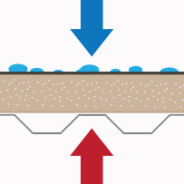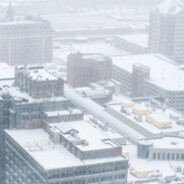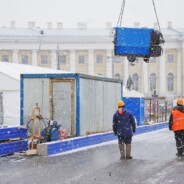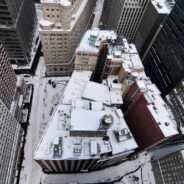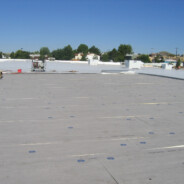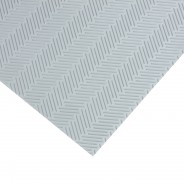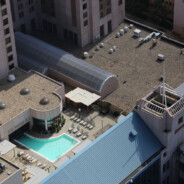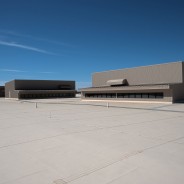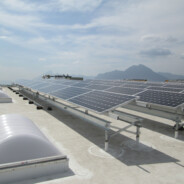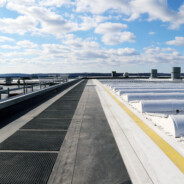Education
Roof Moisture
Roof moisture or leaks often go unnoticed until a problem presents itself that requires immediate action. However, leading up to that point there is often other hidden and not so hidden damage occurring. Insulation Damage Moisture entering a roof system can be absorbed by the insulation layer first, and then shows up as an interior leak. By this time, the moisture collection breaks down the roof insulation so it no longer offers the same R-value to the building. That is why it is important to use moisture-resistant insulation such as GenFlex’s Polyisocyanurate (Polyiso). Other insulating materials such as Expanded Polystyrene (EPS or Bead Board) can absorb water. Roof Blistering Moisture trapped inside a roof system can...
read moreProtect Your Roof This Winter
It’s January and whether we like it or not winter is here! If you live in a cold climate, GenFlex’s Ben George, Technical Building Solutions Manager, has some tips to help protect your roof this winter. He recommends inspections and maintenance, removal of excessive snow, and proper removal of ice accumulations. Inspection and Maintenance Establishing a regular inspection and maintenance program with a GenFlex contractor is highly recommended. The National Roofing Contractors Association (NRCA) suggests at least two visits annually, usually one before winter and another in the spring. Work with your GenFlex contractor to identify and repair areas of concern and perform routine maintenance to prevent leaks and preserve existing...
read moreWinter Safety Tips for Roofing Contractors
It’s December and for those of us in cold climates, it is time to be thinking again about winter safety. Here are some things to keep in mind. Winter Fall Safety Falls are always a concern for roofers, but when you add ice and snow to the mix, your crew must be prepared. In addition to all of your normal fall prevention procedures, make sure to warn your crew that a layer of snow can be covering a dangerous ice layer. Make them aware that deep snow can cover trip hazards such as conduits and pipes. Drifting snow can also cover skylights, so have the building management point out their locations to your crew prior to them getting onto the roof. Set up safety guard rails on the parameters of the roofs for added protection. Remember...
read morePreparing for Winter Weather
Winter begins this year on December 21, at 5:44 a.m. EST. Are you ready? The National Oceanic and Atmospheric Administration (NOAA) is predicting wetter, cooler conditions in the northern U.S. for this winter. It is important to be prepared for the snow, ice and wind that can impact your rooftop. Snow If you are located in an area where snow fall is likely, it is a good idea to have a plan in place. In the winter of 2014–15, Boston received a record 110.6 inches of snow! Roofs in that area weren’t designed to handle that type of snow load, and there were many roofs that collapsed. In fact, Boston Magazine called the collapsing roofs an epidemic. It is a good idea to learn about snow loads and how they impact your...
read moreRoofing Insulation Overview
If you want an energy-efficient roof, the first place to start is insulation. Proper insulation is one of the most important contributors to a building’s energy efficiency. Having a high R-value for your roof, the common measurement of thermal resistance, can also aid in achieving LEED® v4 and RoofPoint(TM) certifications. What’s Recommended The National Roofing Contractors Association (NRCA) recommends using two layers of insulation. This can be comprised of two layers of insulation boards or a single layer of insulation and a cover board. Always follow your local building codes when choosing the materials for a roof. Comparison of Three Types of Foam Insulation Type Advantages Caveats Polyisocyanurate...
read moreWalkway Pads: Protection for Your Roofing Investment
It is sometimes assumed that since workers aren’t on a roof every day that worrying about how your roof handles foot traffic is not important. However, today more than ever, roofs are experiencing more foot traffic than you may realize. The typical building rooftop is becoming a crowded place. Technology such as Wi-Fi antennas, satellite and microwave dishes, cell phone communication equipment and solar panels have joined HVAC systems, pipes, ducts, conduits, skylights, elevator equipment and more, all requiring access and maintenance. Green roofs are also becoming more popular and definitely require accommodations for the additional foot traffic. Not to mention the roof itself needs to inspected and maintained on a regular basis....
read moreBallasted Roofs Are Cool!
You may not think that a roofing system developed almost fifty years ago could be environmentally friendly. While it’s true not many people were thinking green back then, it turns out ballasted roofs are indeed eco-friendly and worth a look. Ballasted roofs consist of thermal insulation boards (such as the GenFlex Polyiso product), EPDM single‑ply membrane (such as GenFlex FRM EPDM or AFR EPDM), and are topped with smooth, river‑washed stone or concrete pavers. They are easy and quick to install since they require no fasteners and no adhesives, which can be a source of Volatile Organic Compounds (VOCs). Ballasted roofs are also economical and long-lasting. The ballast material protects the membrane from harmful UV rays and...
read moreSmart Roofs
As a facility manager, would you like to be notified immediately by text or e-mail if a roof leak is developing, or that the snow load on your roof is becoming dangerous, or how about if a roof drain is blocked? Well, it is all possible with a smart roof. A smart roof uses electronic sensors to detect a problem. The sensors are connected to an electronic control panel. Some systems are stand-alone systems and others integrate with your Building Management System or alarm system. Leak Detection Membrane Monitoring Big leaks usually start off small, so the sooner you know there has been a breach in your roofing membrane, the better. Moisture detectors can provide you with that information quickly, even before there are visual indications...
read moreSolar Panel Installation Considerations
Solar panels are becoming more and more prevalent, and maybe you have been tasked with having some installed on your building. However, like with anything else, it is wise to do some research up front. While examining competing solar technologies to determine what will work best, also consider the impact of installing solar panels on your rooftop. There are four primary methods of attaching solar panels: Ballasted—Panels are held in place by weighted material and do not require roof penetration. This is a popular installation method. Penetrating—Panels are mounted on roof supports that penetrate the roof. These should be structurally attached and properly flashed. This method securely attaches the panel and provides good wind...
read moreFall Protection
In April 2016, a 24-year old roofing worker died on the job due to the failure of his employer to have adequate fall protection and training, according to federal investigators. Unfortunately, he was not alone. Falls are the leading cause of death in the construction industry. According to the Bureau of Labor Statistics, the fatal work injury rate for roofers in 2014 was 46.2 per 100,000 full-time equivalent (FTE) workers. The Occupational Safety and Health Administration (OSHA) takes this issue seriously and will cite and fine roofing companies for failure to provide adequate fall protection. Just to name a few, on September 8, 2016, OSHA cited an Ohio company with proposed penalties of $94,064; on August 15, 2016, OSHA cited a...
read more
